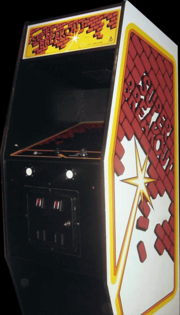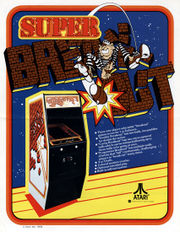Lost In Translation/Super Breakout
| Super Breakout | |
|---|---|
| Manufacturer | Atari |
| Released | 1978 |
| Control Method |
Paddle 1 Button(s) |
| Main CPU | M6502 (@ 375.000 kHz) |
| Sound CPU | Mono DAC |
| Video Details |
Raster (Vertical) 256 x 224 pixels 60.00 Hz 2 Palette colours |
| Screens | 1 |
| ROM Info | 8 ROMs 7,488 bytes (7.31 KiB) |
| MAME ID | sbrkout |
About The Game
Super Breakout is an arcade video game sequel to 1976 original.
Three Game Types
The game allows the player(s) to select any one of three different action-packed Super Breakout games by turning the game select knob on the control panel to the desired game. The three available Super Breakout modes are the following :
Double Breakout
Before serving the ball, the Double Breakout play-field contains 52 orange bricks (4x13) at the top of the screen and 52 green bricks (4x13) immediately below the orange brick wall.
Two paddles are displayed at the bottom end of the screen. When the serve button is pressed two balls are served. If the first ball served is missed, it counts as a missed serve and goes against the players allotted serves per game; otherwise the second ball is served. If the second ball served is missed after striking the first served ball, the player may continue with the first ball.
Cavity Breakout
Before serving the ball, the Cavity Breakout play-field contains 44 orange bricks and 52 (4x13) green bricks located immediately below the orange brick wall. At approximately 3 columns in and 2 rows down into the orange brick wall, from both the left and the right side of the wall, two cavities appear. These two cavities occupy the space of 4 bricks (a 2x2 brick area).
One paddle is provided in this game, and only one ball is served, unlike Double Breakout. When enough bricks are removed to release a captive ball from its cavity, the score doubles for each brick removed by any of the two balls in the play-field (as long as the served and freed ball remain active in the play-field). If the third ball is freed and all three balls are played in the play-field, the score triples. If any one of the balls is missed and lost, the score returns to double points. If the second ball is missed and only one ball remains in the play-field, points are then scored as normal.
Progressive Breakout
Before serving the ball, the Progressive Breakout play-field contains 4x13 brick walls (one blue and the other green). The blue brick wall, which consists of 52 bricks, is at the top. Then occurs a space equivalent to this wall. In the middle of the screen is a green brick wall consisting of 52 bricks.
The brick walls move or 'scroll' toward the paddle at a rate determined by the number of hits on the ball. As the bricks are knocked out and the walls progressively creep up on the player's paddle, new bricks enter the play-field at a progressively faster rate; four rows of bricks are always separated by four rows of blanks.
As the brick walls scroll down, their colours change which indicates a new point score for that brick at that instant of time.
Trivia
Approximately 4,800 units were produced.
This game is also known as "Super Knockout" (licensed to Subelectro).
Scoring
Double Breakout Mode
The maximum score for this mode is 2,694: -
| Brick Colour | Row | Points with 1 ball in play-field |
Points with 2 balls in play-field |
|---|---|---|---|
| Orange | 1 | 7 | 14 |
| Orange | 2 | 7 | 14 |
| Orange | 3 | 5 | 10 |
| Orange | 4 | 5 | 10 |
| Green | 1 | 3 | 6 |
| Green | 2 | 3 | 6 |
| Green | 3 | 1 | 2 |
| Green | 4 | 1 | 2 |
Cavity Breakout Mode
The maximum score for this mode is 3,384: -
| Brick Colour | Row | Points with 1 ball in play-field |
Points with 2 balls in play-field |
Points with 3 balls in play-field |
|---|---|---|---|---|
| Orange | 1 | 7 | 14 | 21 |
| Orange | 2 | 7 | 14 | 21 |
| Orange | 3 | 5 | 10 | 15 |
| Orange | 4 | 5 | 10 | 15 |
| Green | 1 | 3 | 6 | 9 |
| Green | 2 | 3 | 6 | 9 |
| Green | 3 | 1 | 2 | 3 |
| Green | 4 | 1 | 2 | 3 |
Progressive Breakout Mode
The maximum score for this mode is infinite: -
| Brick Colour | Points |
|---|---|
| Blue | 7 |
| Orange | 5 |
| Green | 3 |
| Yellow | 1 |
Tips and tricks
Ball Speed
Besides the slowest ball speed, right after the serve, there are three possible speed-ups. The first speed-up after the serve occurs on the 4th hit, and a second faster speed-up occurs on the 8th hit. The third occurs after the 12th hit and the fourth occurs when a highpoint (either a 5- or 7-point) brick is hit, regardless of previous speed. Ball speed is restored to slowest value at the beginning of each serve.
Ball Direction
When the ball intercepts the paddle it will rebound in any of four directions, depending on which portion of the paddle was hit (divide the paddle in four equal portions). This is still the case after the paddle has been reduced to half its normal size. Note that the ball is not allowed to move in a direction perpendicular to the front surface of the paddle or perpendicular to the edge of the paddle. These directions change with the number of hits of the balls. Just like the ball speed changes occur at the 4th, 8th and 12th ball hits.
Series
- Breakout (1976)
- Breakout Deluxe (1976)
- Super Breakout (1978)
- Breakout 2000 (1997, Atari Jaguar)
Staff
- Designed & Programmed By
- Ed Logg
Cabinet and Artwork
Ports
- Consoles
- Atari 2600 (1978)
- Mattel Intellivision (1981, "Brickout!")
- Atari 5200 (1982)
- Atari XEGS
- Sega Master System (1992, "Arcade Smash Hits")
- Nintendo Game Boy (1996, "Battlezone / Super Breakout")
- Sony PlayStation (1996, "Arcade's Greatest Hits - The Atari Collection 1")
- Nintendo Super Famicom (1997, "Arcade's Greatest Hits - The Atari Collection 1")
- Sega Saturn (1997, "Arcade's Greatest Hits - The Atari Collection 1")
- Atari Jaguar (1997, "Breakout 2000")
- Nintendo Game Boy Color (1998)
- Sony PlayStation (2001, "Atari Anniversary Edition Redux")
- Sega Dreamcast (2001, "Atari Anniversary Edition")
- Nintendo Game Boy Advance (2002, "Atari Anniversary Advance")
- Sony PlayStation 2 (2004, "Atari Anthology")
- Microsoft XBOX (2004, "Atari Anthology")
- Nintendo Game Boy Advance (2005, "Millipede / Super Breakout / Lunar Lander")
- Computers
- Atari 400 (1979)
- BBC B (1982, "Acornsoft Breakout" - Acornsoft)
- Atari ST (1987)
- PC [MS Windows, CD-ROM] (1999, "Atari Arcade hits 1")
- PC [MS Windows, CD-ROM] (2001, "Atari Anniversary Edition")
- PC [MS Windows, CD-ROM] (2003, "Atari - 80 Classic Games in One!")
- Others
- Atari Paddle TV Game (2004 - Jakk's Pacific)
- Nokia N-Gage (2005, "Atari Masterpieces Volume 1")
Soundtrack Releases
| Album Name | Catalogue No. | Released | Publisher | Comments |
|---|---|---|---|---|
| The Story of Super Breakout | KSC-88944[1] | 1982-01-01 | Kid Stuff Records & Tapes | Cassette version. |









